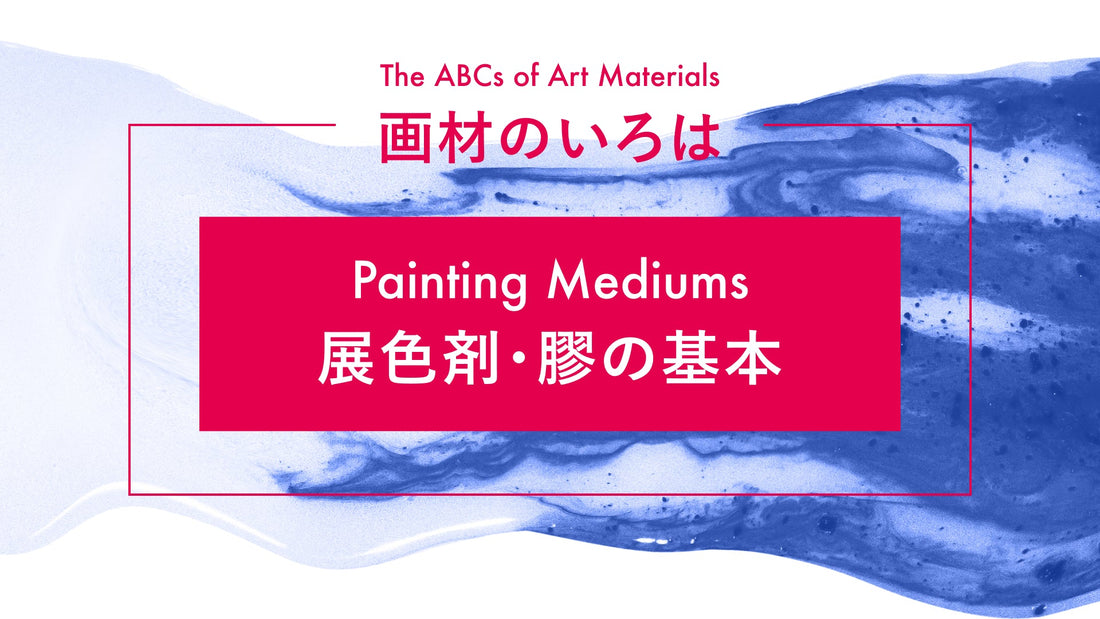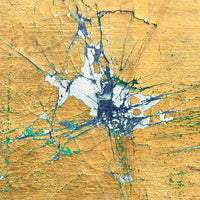—What is a binder?
Pigments, which are color powders, cannot be fixed to paper or canvas by themselves. To use as paint, they require binders to be mixed with. The tube paints we are familiar with in school art supplies are generally made of pigments and binders. Binders are also sometimes referred to as mediums or vehicles.
—What is animal glue (Nikawa) ?
Animal glue, also known as Nikawa in Japanese, is a gelatinous binder extracted by boiling the bones and skins of animals such as cows, pigs and fish. In the East, it has been used as a pigment binder, a gilding glue and a dosa sizing solution for paper, while in the West, it has been used as an adhesive in making musical instruments and gesso grounds for painting.
Solid animal glue is dissolved in hot water before use. When choosing animal glue, the types of raw materials and the concentration of the solution vary according to the purpose of use.
—What is a medium?
In art, the term “medium” means materials used to create a work of art, as well as the type of art (e.g. painting, sculpture, printmaking). In some cases, it refers only to the “binders” that adhere pigments to the substrates (paper, canvas, etc.), while in other cases, medium indicates materials used for various expressions. In addition to being used as an adhesive, there are a wide variety of painting mediums designed for different purposes, such as creating a glossy texture, leaving brush marks, controlling the drying speed of paint, and more.
—How can you use mediums in painting?
“Paint” is made by mixing pigment and binder.
At PIGMENT TOKYO, we mainly offer three types of pigments: Mineral Pigments used for Japanese painting, Pigments (fine powders) for watercolors and oil paints and Effect Pigments, which have luminosity and sheen.
For more information on pigments and how paints are made, please refer to the related articles below.
[Related article] PIGMENT ARTICLE
The ABCs of Art Materials —Pigments—(Q. What types of pigments are there?)
How to Make Your Own Paint
—Which binders to choose when making paints?
You can select the binder according to the type of paint you would like to make. You can see the characteristics of watercolors, acrylic paints, oil paints and traditional Japanese paints (Iwa-Enogu) in the chart and related articles below.
Binders also vary depending on what types of pigments, substrates and painting techniques you use.
|
Types of Paints |
Properties |
Binders |
|---|---|---|
|
Watercolors |
Non-water-resistant Water-based |
|
|
Acrylic paints |
Water-resistant Water-based |
|
|
Oil paints |
Water-resistant Oil-based |
Oil Color Medium / Oil Mediums |
|
Traditional Japanese Paints (Iwa-Enogu) |
Semi-water-resistant Water-based |
Animal Glue (Nikawa) |
[Related article] PIGMENT ARTICLE
Pigments + Mediums = ???
—What are the characteristics of each binder?
The following are the basic binders that are easy to handle, especially for beginners.
Gum Arabic Medium
・It melts again when wetted with water even after solidifying.
・Weak adhesion.
Acrylic Emulsion / Acrylic Mediums
・It forms a film upon drying, providing water resistance.
・Strong adhesion.
Oil Color Medium / Oil Mediums
・It doesn't dissolve in water, so it must be thinned with an oil such as turpentine.
・It produces a glossy and durable paint film.
・Dries slowly.
Animal Glue (Nikawa)
・Ideal for layering paint to highlight the color and texture of the pigment.
・Highly flexible and strong adhesion.
・Has good affinity with water and changes into solid, gelatinized or liquid depending on temperature.
—Can different types of binders be mixed and used together?
In general, it's recommended to use the same binder on a single surface to ensure better adhesion and compatibility with the substrate, which improves the painting's longevity. However, it is possible to mix water-based binders with other water-based binders, or oil-based binders with other oil-based binders, to adjust the level of adhesion.
When combining water-based and oil-based binders, you can paint with oil mediums over a water-based paint. However, you cannot paint with a water-based paint over oil paint.
Because the choice of binder depends on the type of pigment and substrate, it's important to test before using them in your artwork.
Translated by Atsumi Okano, Nelson Hor Ee Herng
PIGMENT TOKYO Art Materials Experts








